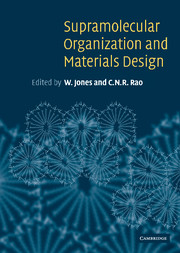Book contents
- Frontmatter
- Contents
- List of contributors
- Preface
- 1 Assembly and mineralization processes in biomineralization: strategies for forming biological composite materials
- 2 Mesoscale materials synthesis and beyond
- 3 Towards the rational design of zeolite frameworks
- 4 Mesoscale self-assembly: the assembly of micron-and millimeter-sized objects using capillary forces
- 5 Design of amphiphiles for the modulation of catalytic, membranous and gelation properties
- 6 Nanofabrication by the surface sol-gel process and molecular imprinting
- 7 The hierarchy of open-framework structures in metal phosphates and oxalates
- 8 Mesoscale self-assembly of metal nanocrystals into ordered arrays and giant clusters
- 9 Layered double hydroxides as templates for the formation of supramolecular structures
- 10 Molecular machines
- 11 Some aspects of supramolecular design of organic materials
- 12 Controlling crystal architecure in molecular solids: the supramolecular approach
- Index
7 - The hierarchy of open-framework structures in metal phosphates and oxalates
Published online by Cambridge University Press: 18 December 2009
- Frontmatter
- Contents
- List of contributors
- Preface
- 1 Assembly and mineralization processes in biomineralization: strategies for forming biological composite materials
- 2 Mesoscale materials synthesis and beyond
- 3 Towards the rational design of zeolite frameworks
- 4 Mesoscale self-assembly: the assembly of micron-and millimeter-sized objects using capillary forces
- 5 Design of amphiphiles for the modulation of catalytic, membranous and gelation properties
- 6 Nanofabrication by the surface sol-gel process and molecular imprinting
- 7 The hierarchy of open-framework structures in metal phosphates and oxalates
- 8 Mesoscale self-assembly of metal nanocrystals into ordered arrays and giant clusters
- 9 Layered double hydroxides as templates for the formation of supramolecular structures
- 10 Molecular machines
- 11 Some aspects of supramolecular design of organic materials
- 12 Controlling crystal architecure in molecular solids: the supramolecular approach
- Index
Summary
After providing a brief description of zeolitic structures, we discuss the hierarchy of structures of open-framework metal phosphates ranging from zerodimensional monomeric units and one-dimensional linear chains to complex three-dimensional structures. Aspects related to the likely pathways involved in the assemblage of these fascinating structures are examined, pointing out how the formation of the complex three-dimensional structures of open-framework metal phosphates involves the transformation and assembly of smaller units. Besides the role of the four-membered monomer, the amine phosphate route to the formation of the three-dimensional structures is discussed. The last step in the formation of these structures from preformed units of the desired structure is likely to be spontaneous. Our recent studies of open-framework metal oxalates have shown the presence of a hierarchy of structures. Reactions of amine oxalates with metal ions yield members of the oxalate family with differing complexity.
Introduction
Zeolites and related aluminosilicates constitute a vital family of microporous materials with immense applications in catalysis, sorption and separation processes [1–3]. The discovery of aluminophosphates is an important landmark in the science of these materials [4]. All these materials are, in general, synthesized under hydrothermal conditions by making use of template molecules [2]. The template molecules are usually organic amines and they are involved in the formation of these framework structures in more ways than one.
- Type
- Chapter
- Information
- Supramolecular Organization and Materials Design , pp. 214 - 264Publisher: Cambridge University PressPrint publication year: 2001



